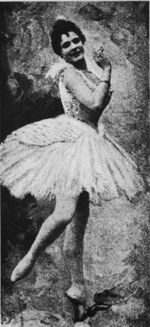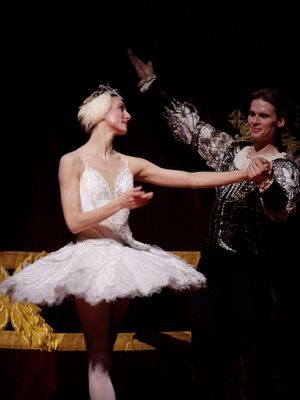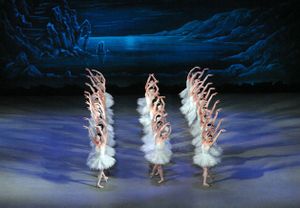بحيرة البجع
| هذا الموضوع مبني على مقالة لابراهيم العريس. |
بحيرة البجع باليه تأليف المسيقي الروسي بيتر تشايكوفسكي عام 1876.
المؤلف
عاش بيتر تشايكوفسكي بين 1840 و1895، ويعتبر واحداً من كبار الموسيقيين الروس هو الذي ولد ومات في سانت بطرسبرغ، لكنه أمضى سنوات كثيرة في خارجها، ليس في موسكو فقط، بل كذلك في انحاء عدة من أوروبا ولا سيما في العاصمة الفرنسيةباريس، التي سيقول دائماً انها علمته الكثير، وذلك على الضد من قول مواطنه ثيودور دوستويفسكي بأن باريس لم تعلمه شيئاً. وتشايكوفسكي الذي عاش طفولة مرفهة قرر منذ الصغر ان يصبح موسيقياً، وذلك منذ مشاهدته المبكرة لأوبرا موزارت «دون جوان» التي تركت لديه تأثيراً لم يمح أبداً. وهكذا، حتى وإن كان درس الحقوق إطاعة لأبيه، راح يهتم بالموسيقى أكثر وأكثر حتى انضم الى الكونسرفاتوار ودرس العزف والتأليف ثم صار أستاذاً فيه وبدأ يكتب تلك الأعمال الخالدة التي كرسته، خلال عقدين من الزمن واحداً من كبار موسيقيي العالم كله والأزمان كلها.
بالنسبة الى كثر من دارسي فن بيتر تشايكوفسكي ونقاد أعماله، لا يمكن اعتبار «بحيرة البجع» عملاً كبيراً من بين أعمال هذا المؤلف الموسيقي الروسي الكبير. هؤلاء يفضلون دائماً، أعمالاً له أكثر تركيبية مثل «كسارة الجوز» و «الحسناء النائمة في الغابة» في مجال الباليه، أو «السيمفونية السادسة» (الأخيرة له)، أو حتى كونشرتو البيانو والأوركسترا. ومع هذا إذا ذكر احد اسم تشايكوفسكي امام أي جمع من الناس سيكون باليه «بحيرة البجع» أول ما يخطر على البال من أعماله. بل ان في موسيقى هذا الباليه «الرومانسي» الساحر ما يرد الى المرء الحب للموسيقى، حين يتنزه في غابة بمفرده، كما يقول واحد من كاتبي سيرة الموسيقى. وهذا الباليه الذي ألفه تشايكوفسكي عام 1876، ليكون واحداً من أشهر أعماله لاحقاً، هو واحد من أعمال قليلة كتبها الفنان الذي كان في ذروة تألقه في ذلك الحين، بناء على توصية وليس بمبادرة شخصية منه، كما كانت حاله مع أعمال أخرى كثيرة له. والحكاية ان مسرح الفن الكبير (البولشوي) في موسكو، كان هو الذي طلب من تشايكوفسكي ان يضع موسيقى باليه انطلاقاً من أسطورة قديمة، ألمانية الأصل. والفنان وضع تلك الموسيقى خلال تلك السنة، في وقت كان يقوم بجولة فنية- صحية في باريس. ولعل الارتباط هنا بين فن موسيقي روسي (حتى وإن كان «مغرّباً» بحسب توصيف بعض نقاد ذلك الزمن) ونص اسطوري جرماني، واستلهام فرنسي – باريسي مباشر، كان هو ما أعطى «بحيرة البجع» طابعه العالمي ومذاقه الشديد الحداثة في ذلك الحين.
التاريخ
القصه
و تبنى قصة «بحيرة البجع» على تلك الحكاية التي تتحدث عن أمير يدعى سيغفريد، كان يقوم برحلة صيد في الغابات بالقرب من بحيرة، حين يجهز قوسه وسهامه للاصطياد بين سرب من البجع البيضاء الجميلة التي يلتقيها بالقرب من ضفة البحيرة. وفي اللحظة ذاتها التي كان الأمير الشاب يهم بإطلاق السهم، تتحول البجعات الى مجموعة من الكائنات البشرية الفائقة الجمال. بيد ان ثمة من بين البجع واحدة هي أميرتهن الأكثر جمالاً ورهافة، لكنها بسبب لعنة أحلتها عليها ساحرة شريرة، تبدو غير قادرة على ان تستعيد بدورها، سماتها الإنسانية، إلا حين تقع في حب شاب تتزوجه. وهنا، إذ يطّلع سيغفريد على هذه الحكاية وعلى هذا الشرط، يعد البجعة الفاتنة بالزواج ويعلن لها حبه، مؤكداً لها انه – بالتالي – سيساعدها على استعادة إنسانيتها. غير ان الأمير سرعان ما ينسى هذا الوعد بعد ذلك ويختار لنفسه بجعة/ فتاة حسناء أخرى. بعد ذلك، في الوقت الذي تكون الاستعدادات قائمة على قدم وساق للاحتفال بخطبة سيغفريد على فاتنته الجديدة، يصل الى مسمعه صراخ عصفور سرعان ما يذكره بوعده. ولكن في تلك اللحظة يكون الأوان قد فات، ومن هنا، حين يتوجه الأمير الى البجعة – الأميرة التي كان قد نسي وعده لها، طالباً منها المغفرة لعدم وفائه بذلك الوعد، تذهب كل جهوده أدراج الرياح. لأن مثل هذا الأمر لا يمكن ابداً التسامح معه. وببساطة لأن البجعة الحسناء أحبته بالفعل ولم تعد قادرة على ان تحب غيره. وبالتالي فإن «خيانته» لها كانت قاضية عليها، لأنها حالت «الى الأبد» دون استعادتها إنسانيتها. فكيف يمكنها ان تسامحه وقد أضاع عليها فرصتها الوحيدة؟
عندما يعجز سيغفريد عن نيل غفران الأميرة البجعة، يغرق من فوره في أعتى درجات اليأس والحزن. وإذ يكون في تلك الحال، يقدم، في لحظة موت مطلق، على انتزاع تاج الأميرة من على رأسها، مع انه يعرف ان هذا التاج هو الوحيد الذي يحميها من الهلاك غرقاً، وهكذا تغرق الأميرة البجعة ويغرق هو معها، فيما من بعيد تواصل البجعات الحسناوات رقصهن على إيقاع موسيقى النهاية.
منذ تقديمه للمرة الأولى على مسرح الفن في موسكو، عرف باليه «بحيرة البجع» مصيراً بائساً. ففي البداية، وجد القيمون على المسرح ان الباليه طويل جداً ويستغرق تقديمه زمناً استثنائياً. ومن هنا عمدوا الى قطع بعض اجزائه. ما أثار غضب المؤلف، وكذلك غضب الجمهور الذي لم يفته ذلك الأمر، علماً بأن القطع كان من الغباء بحيث تترجم، حقاً، في قطع بيّن في الانسياب الموسيقي نفسه. بعد ذلك بدا واضحاً، للأذن الخبيرة ان الموسيقى التي وضعها تشايكوفسكي لهذا الباليه، اتت متفاوتة القيمة بين لحظات وأخرى، حيث الى جانب مقطوعات شديدة الروعة (لعل أجملها، ودائماً بحسب الخبراء، مقدمتا الفصلين الأول والثاني)، ثمة لحظات تبدو أقل من عادية ومكررة، وأحياناً مأخوذة من أعمال أخرى لتشايكوفسكي، ولقد بدا هذا كله واضحاً، على رغم ان الجمهور يستمتع في النهاية استمتاعاً استثنائياً بالخاتمة الشاعرية والانسيابية التي يضعها النقاد عادة بين أجمل ما كتبه تشايكوفسكي خلال مساره التأليفي المدهش، حيث نراه يصل هنا الى نوع من التعبير الدرامي المثير، حتى وإن كان المؤلف نفسه، حين كان – بعد العروض الأولى – يتحدث عن هذا العمل، يقول انه عمل صغير من أعماله وأنه ما كتبه إلا على سبيل تمضية أوقات كانت صعبة عليه. غير ان تشايكوفسكي لم يكن محقاً في ذلك، حيث ان «بحيرة البجع» – وكما يقول كثر من دارسي فنون تلك المرحلة – أتى في حينه ليعيد الى موسيقى الرقص كل أهميتها وجمالها في وقت كان هذا النوع من الموسيقى، يعيش انحطاطاً كبيراً، إذ بسبب رواج عروضه التجارية والشعبية التي راح يكتسبها، صار مجالاً مفضلاً لكل الذين لا موهبة حقيقية لهم، كي يجربوا حظوظهم، ويحققوا نجاحات سريعة. وإذا كان تشايكوفسكي نظر أول الأمر الى هذا العمل على انه ينتمي الى ذلك التطور وأنه ما كتبه إلا ليجاري به زمن الانحطاط، فإن كثراً من الدارسين رأوا يومها ان الموسيقى التي كتبها مؤلف «كسارة الجوز» لذلك العمل كانت هي ما أعاد الارتقاء بفن كتابة الموسيقى الراقصة الى مستويات رفيعة. ولقد أثبت الزمن خلال اكثر من قرن وربع القرن أن هؤلاء كانوا على حق، أما تشايكوفسكي فكان على خطأ بيّن.
أصول تأليف بحيرة البجع
تشايكوفسكي التأثيرات
تاريخ الأداء

العرض الأول
- Date: 4 March (O.S. 20 February), 1877
- Place: Bolshoy Theatre, Moscow
- Balletmaster: Julius Reisinger
- Conductor: Stepan Ryabov
- Scene Designers: Karl Valts (Acts 2 & 4), Ivan Shangin (Act 1), Karl Groppius (Act 3)
افتتاحية سانت پطرسبورگ
- Date: 27 January 1895
- Place: Mariinsky Theatre, St. Petersburg
- Balletmaster: Marius Petipa (Acts 1 & 3), لڤ إيڤانوڤ (Acts 2 & 4)
- Conductor: Riccardo Drigo
- Scene Designers: Ivan Andreyev, Mikhail Bocharov, Henrich Levogt
- Costume Designer: Yevgeni Ponomaryov[1]
Other Notable Productions
- 1880 and 1882, Moscow, Bolshoy Theatre, staged by Joseph Hansen after Reisinger, conductor and designers as in premiere
- 1901, Moscow, Bolshoy Theatre, staged by Aleksandr Gorsky, conducted by Andrey Arends, scenes by Aleksandr Golovin (Act 1), Konstantin Korovin (Acts 2 & 4), N. Klodt (Act 3)
- 1911, London, Ballets Russes, Sergey Dyagilev production, choreography by Mikhail Fokin after Petipa-Ivanov, scenes by Golovin and Korovin
المفسرون الأصليون
| Rôle | موسكو 1877 | موسكو 1880 | سانت پطرسبورگ 1895[1] | موسكو 1901 | لندن 1911 |
|---|---|---|---|---|---|
| الأميرة | Olga Nikolayeva | Giuseppina Cecchetti | |||
| سيگفريد | A. Gillert | Alfred Bekefi | Pavel Gerdt | ميخائيل موردكين | Vatslav Nizhinsky |
| بنو | Sergey Nikitin | Aleksandr Oblakov | |||
| Wolfgang | Wilhelm Wanner | Gillert | |||
| اوديت | Pelageya Karpakova | Yevdokiya Kalmїkova | Pierina Legnani | Adelaide Giuri | Matilda Kshesinskaya |
| Von Rothbart | Sergey Sokolov | Aleksey Bulgakov | K. Kubakin | ||
| Odile | Pierina Legnani | Matilda Kshesinskaya |
الإنتاج الأصلي في 1877
Tchaikovsky Pas de Deux 1877
Subsequent productions 1879-1894
Petipa-Ivanov-Drigo revival of 1895
الانتاجات اللاحقة
الآلات الموسيقية
- Strings: violins I and II, violas, violoncellos, double basses
- Woodwinds: piccolo, 2 flutes, 2 oboes, 2 clarinets in B-flat, A and C, 2 bassoons
- Brass: 4 horns in F, 2 cornets in A and B-flat, 2 trumpets in F, D, and E, 3 trombones (2 tenor, 1 bass), tuba
- Percussion: timpani, snare drum, cymbals, bass drum, triangle, tambourine, castanets, tam-tam, glockenspiel
- Other: harp
الأدوار
- The Sovereign Princess
- Prince Siegfried, her son
- Wolfgang, his tutor
- Benno von Sommerstern, the Prince's friend
- Odette, the Swan Princess
- von Rothbart, an evil genius, by appearance a guest
- Odile, his daughter, who resembles Odette
- Master of Batons
- Baron von Stein
- The Baroness, his wife
- Freiherr von Schwarzfels
- His wife
- A herald
- A footman
- Court gentlemen and ladies, friends of the prince, heralds, guests, pages, villagers, servants, swans, cygnets
أوديت
سيگفريد
ملخص القصة
نهايات بديلة
Adaptations
Live action film
- The opening credits for the 1931 version of Dracula starring Béla Lugosi includes a modified version of the Scène from Act II.
- Darren Aronofsky's 2010 film Black Swan concerns characters who are performers in Swan Lake and follows the plot of the fairy tale in a contemporary idiom.
- Harry Wondrous World from the Harry Potter and the Sorcerer's Stone Soundtrack starts with a theme from Swan Lake Ballet, Op. 20
الأكروبات
- The Guangzhou Acrobatic Troupe of China has made an acrobatic version of the ballet. It is on tour around the world. It contains such acrobatic moves as Odette doing a pirouette on top of Siegfried's head, without any supports. It contains Tchaikovsky's music.
Animated theatrical and direct-to-video productions
ألعاب الكمبيوتر
الأدب
- Amiri & Odette (2009) is a verse retelling by Walter Dean Myers with illustrations by Javaka Steptoe. Myers sets the story in the Swan Lake Projects of a large city. Amiri is a basketball-playing “Prince of the Night”, a champion of the asphalt courts in the park. Odette belongs to Big Red, a dealer, a power on the streets.
- The Black Swan (1999) is a fantasy novel written by Mercedes Lackey that re-imagines the original story and focuses heavily on Odile. Von Rothbart's daughter is a sorceress in her own right who comes to sympathize with Odette.
- Swan Lake (1989) is a children's novel written by Mark Helprin and illustrated by Chris van Allsburg, which re-creates the original story as a tale about political strife in an unnamed Eastern European country. In it, Odette becomes a princess hidden from birth by the puppetmaster (and eventually usurper) behind the throne, with the story being retold to her child.
الموسيقى
- Odette – The Dark Side of Swan Lake, a musical written by Alexander S. Bermange and Murray Woodfield, was staged at the Bridewell Theatre, London in October 2007.
- In Radio City Christmas Spectacular', The Rockettes do a short homage to Swan Lake during the performance of the Twelve Days of Christmas (Rock and Dance Version), with the line "Seven Swans A-Swimming."
- Billy Elliot the Musical incorporates the most famous section of Swan Lake in a dance number, in which the main character dances while shadowed by his future, adult self.
التلفزيون
- The 2002 anime Princess Tutu (2002) frequently alludes to Swan Lake. The heroine, Ahiru, whose costume design is reminiscent of Odette's, is a duck transformed by a sorcerer into a girl (rather than the other way around), while her antagonist, Rue, dressed as Odile, is a girl who had been raised to believe she is a raven. The score of Swan Lake, along with that of The Nutcracker, features heavily throughout, as does, occasionally the Petipa choreography, most notably in episode 13, where Ahiru dances the climactic Pas de Deux alone, complete with failed lifts and catches.
- In the second season of the anime Kaleido Star, a circus adaptation of Swan Lake becomes one of the Kaleido Stage's most important and successful shows. Main character Sora Naegino plays Princess Odette, with characters Leon Oswald as Prince Siegfried and May Wong as Odile.
- In the Japanese tokusatsu show Kamen Rider Den-O, the main protagonist has the ability to take different forms, based on the "imagin" that possess him. One of the imagin, known as Sieg, is analogous to the legend of Swan Lake, as it acts very princely when possessing Ryoutarou. Its Den-O form, known as the Wing Form, possesses a swan motif on the face plate. The henshin also appears as if a swan alighted on Den-O's mask.
- In Episode 213 of The Muppet Show, Rudolf Nureyev performs "Swine Lake" with a giant ballerina pig.
- Swan Lake was heard in two episodes of the Playhouse Disney series Little Einsteins. The episodes were "Quincy and the Magic Instruments" and "The Blue Footed Boobey Bird Ballot".
الألبومات
صوت
- 1954, Antal Dorati (conductor), Minneapolis Symphony Orchestra (first-ever complete recording, available only in mono)
- 1982, John Lanchbery (conductor), Philharmonia Orchestra
- 1988, Yevgeny Svetlanov (conductor), Russian State Symphony Orchestra
- 1990, Michael Tilson Thomas (conductor), London Symphony Orchestra
- 2006, Valery Gergiev (conductor), Orchestra of the Mariinsky Theatre
فيديو
- 1966, John Lanchbery (conductor), Wiener Symphoniker, Ballet of the Wiener Staatsoper, Rudolf Nureyev (Siegfried), Margot Fonteyn (Odette / Odile)
- 1968, Viktor Fedotov (conductor), Kirov Ballet, Yelena Yevteyeva, John Markovsky, Makhmud Esambayev
- 1976, Algis Zhuraitis (conductor), Bolshoi Ballet, Aleksandr Bogatirev, Maya Plisetskaya (centennial anniversary performance).
- 1982, Ashley Lawrence (conductor), Sadler's Wells Orchestra, Royal Ballet, Natalia Makarova (Odette / Odile), Anthony Dowell (Siegfried)
- 1983, Algis Zhuraitis (conductor), Bolshoi Ballet, Aleksandr Bogatirev, Natalya Bessmertnova
- 1989, Algis Zhuraitis (conductor), Bolshoi Ballet, Yuri Vasyuchenko (Siegfried), Alla Mikhalchenko (Odette / Odile)
- 1990, Viktor Fedotov (conductor), Kirov Ballet, Igor Zelensky (Siegfried), Yuliya Makhalina (Odette / Odile)
- 2002, Michel Queval (conductor), Orchestra and Ballet of the Royal Opera of Stockholm, Anders Nordström (Siegfried), Nathalie Nordquist (Odette / Odile)
- 2004, James Tuggle (conductor), Scala de Milan, Roberto Bolle (Siegfried), Svetlana Zakharova (Odette / Odile)
- 2005, Jonathan Darlington (conductor), Opéra de Paris, Patrick Dupond (Siegfried), Marie-Claude Pietragalla (Odette / Odile)
- 2005, Ormsby Wilkins (conductor), American Ballet Theatre, Angel Corella (Siegfried), Gillian Murphy (Odette / Odile)
- 2007, Valery Gergiev (conductor), Kirov/Mariinsky Ballet, Danila Korsuntsev (Siegfried), Ulyana Lopatkina (Odette / Odile)
المصادر
- ^ أ ب "Swan Lake". American Ballet Theatre. Retrieved 3 December 2010.
بيبلوغرافيا
- Brown, David. Tchaikovsky: The Man and His Music. London, England: Faber and Faber, 2006. 108-119
- Brown, David. "Tchaikovsky's Mazeppa." The Musical Times 125.1702 (1984): 696-698.
- C.W. Beaumont : The Ballet called Swan Lake (London, 1952)
- G. Abraham, ed.: Tchaikovsky: a Symposium (London, 1945/R, R 1970 as The Music of Tchaikovsky)
- Norris, George : Stanford, the Cambridge Jubilee and Tchaikovsky (London, 1980)
- Nuzzo, Nancy B. "Swan Lake: a chronology; The sleeping beauty: a chronology; other Tchaikovsky ballets." Dance magazine, 55 (June 1981), 57-58.
- Pudelek, Janina. "Swan Lake" in Warsaw, 1900. Dance Chronicle, 13 (1990–1991): 359-36
- Wiley, Roland John : Tchaikovsky’s Ballets: Swan Lake, Sleeping Beauty, Nutcracker (Oxford, 1985, 2/1991)
- Review: Robinson, Harlow. "Review: Untitled." The Slavic and East European Journal, 31 (1987): 639-640
وصلات خارجية
الخلفية
- Swan Lake: From Planning to Performance at the Royal Opera House, about the Royal Ballet's production of 'Swan Lake'
- Rudolf Nureyev's choreography of Swan Lake
تسجيلات مرئية للباليه:
- Swan Lake (2005) Murphy and Corella (ABT)
- Lebedinoe ozero (Swan Lake) في قاعدة بيانات الأفلام الإنترنتية (1957)
- Schwanensee في قاعدة بيانات الأفلام الإنترنتية (1967)
- Matthew Bourne's Swan Lake في قاعدة بيانات الأفلام الإنترنتية (1996)
- The Ballet Soloist (aka Russian Ballerina) – 1947 Soviet musical film with scenes from Tchaikovsky's Swan Lake and The Sleeping Beauty. With subtitles in Esperanto.
التسجيل:
- Swan Lake: Free scores at the International Music Score Library Project.
- Articles with hatnote templates targeting a nonexistent page
- المقالات needing additional references from April 2010
- كل المقالات needing additional references
- بحيرة البجع
- باليهات عرضت أول مرة في 1877
- ألحان 1876
- باليهات لـِڤ إيڤانوڤ
- باليهات ماريوس پتيپا
- باليهات پيوتر إليتش تشايكوڤسكي
- باليهات تصميم قسطنطين كوروڤين







